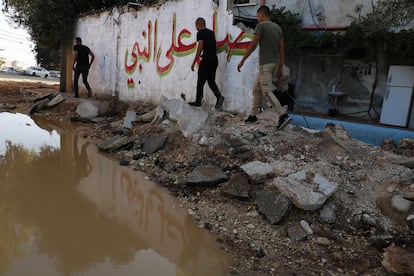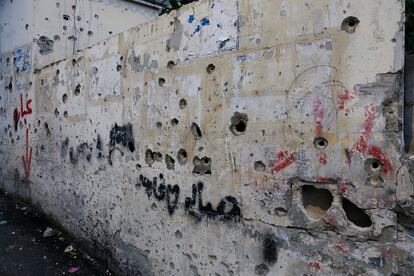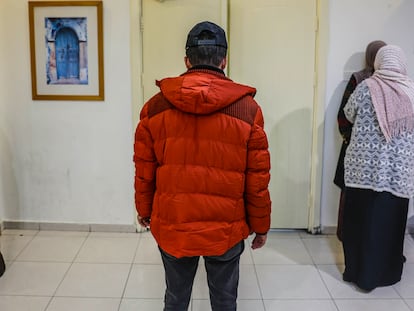Jenin, a West Bank war zone: Drones, snipers, shelling and surrounded hospitals
66% of Palestinians killed since October 7 in the occupied territory died in ‘search and seizure operations’ by the Israeli army in the region and nearby Tulkarem, according to the U.N.

When Asaad al-Damagh was struck down in an alley in the Jenin refugee camp on November 25, two explosions reverberated. The first shell killed al-Damagh; the second one took out Maisa, a 30-year-old Palestinian woman who was trying to help the man by dragging him into her house. The woman’s body was pierced by the same metal pieces that shredded the front of her house, and she managed to get into the hallway. Her eldest son, ten-year-old Riad, said that he had previously seen “something gray in the sky.” This was done by an Israeli army drone. Maisa now lies in a bed in the Ibn Sina hospital in Jenin, a city of about 50,000 inhabitants in the north of the West Bank. She has already undergone three operations to remove shrapnel from her body but cannot see out of one eye. Other patients who have shrapnel in their skulls, like Maisa, says her husband, “have gone blind.”
For many Palestinians, the Jenin refugee camp is a stronghold of resistance against the Israeli occupation. For Israel, this place measuring less than half a square kilometer, where 14,000 displaced individuals, children and grandchildren of the Nakba, are crammed together, is a nest of “terrorists” belonging to Hamas, the Palestinian Islamic Jihad and other organizations. Al Damagh was a member of the second group, who was killed directly and without the possibility of defending himself in court. The “terrorist” status is the one that Israel systematically applies to those killed in Israeli military raids in the city and, particularly, in the countryside. These operations, which have been recurring for decades, have been “ongoing” and occurring up to three times a week since October 7, the day Hamas attacked Israel, explains Luz Saavedra, local coordinator of Doctors Without Borders (MSF), the only international organization working permanently in the field. In the last of these so-called “search and seizure” operations — on November 28 and 29 — the Israeli army announced the death of four of these “terrorists.” One was 8-year-old Adam Samer al Ghouk. Another was 15-year-old Basil Suleiman Abu al Wafa. Two unarmed children who were shot and killed by an Israeli soldier.
From October 7 to November 23, the Israeli military killed 211 people in the West Bank, almost half of the 452 Palestinians who have died for the same reason in 2023. 54 of them were children. Eight other Palestinians — including another child — were killed by Israeli settlers, according to a U.N. Office of Humanitarian Coordination Affairs (OCHA) document. 66% were killed in search and seizure operations, “mainly in the Jenin and Tulkarem governorates,” which are l miles apart.
The streets of the Jenin refugee camp bear witness to this succession of deaths. Every few steps, improvised altars, framed or photocopied photos, pay homage to the numerous men, some women and many children killed by the Israeli military for their suspected association with armed groups. Other faces in these photos are of victims of sniper fire, of crossfire between militia and soldiers, or of the explosions and bombings that occur in these “search and seizure” operations that transform the refugee camp into a war zone. In July, the Israeli army even fired missiles at the refugee camp from two Apache war helicopters.

Weapons of war
The military raids which “have increased in frequency and intensity” in nearly eight weeks of the Gaza war, Saavedra stresses, begin with drones, an ominous presence whose buzzing is often a warning sign that the camp will be declared a “closed military zone” and the Israeli army will raid it. Then the soldiers arrive at sunset, escorted by D-9s, huge military bulldozers that demolish asphalt and sewage systems, even entire walls of houses, which the neighbors no longer bother to repair. Meanwhile, snipers take up positions on rooftops and even inside houses in the countryside. Salah Eddine Mansour, a 28-year-old lawyer, points to the scarred walls. The large holes in the facades are used “by the sniper to slide out the barrel of the gun.” There are other, somewhat smaller holes all over the place — the traces of gunshots. In some of these bullet holes, there is room for a hand. According to several refugees in the street, the soldiers use ammunition that explodes when it enters the body.
66-year-old Emm Haitham points to his son’s car. The vehicle has half of its bodywork crushed like a soda can that has been squeezed between one’s hands. An Israeli bulldozer rolled over it. Next to the houses, long black canvases hang from the power lines. These are to try to hide the streets from Israeli drone cameras, explains the MSF coordinator.
Not far away, a woman opens the door of her house and shows a wall whose upper part has been blown away. An Israeli rocket tore it to pieces, she explains. She then points to the ground and says that, in one raid, a man the soldiers were looking for hid in her courtyard. “They shot him and took him away,” she recalls.
Since the day of the Hamas attack, the Israeli military has escalated attacks on this refugee camp, which was one of the main scenes of the second Palestinian intifada two decades ago. It is also preventing the wounded from getting immediate medical treatment by blocking the entrances to the city’s hospitals, especially to Jenin’s largest public hospital, Khalil Suleiman Hospital, which is next to the camp, the MSF worker explains. Saavedra explains how the soldiers stop the ambulances, search them and ask for documentation from all occupants. This humanitarian worker recounts the case of a 45-year-old man with an intellectual disability, who was shot in the abdomen during an Israeli raid, and who was pronounced dead on arrival because the ambulance could not arrive in time.
MSF is supporting emergencies at the Khalil Suleiman hospital. It has also trained volunteers from the camp, some with previous healthcare experience and others without, to provide basic emergency care to the wounded while ambulances arrive, in what they call “stabilization points” — houses or premises adapted for this purpose. All that remains of one of them, which was bombed in July by the Israeli army, consists of charred walls and crooked bars. MSF has also donated to the volunteers a baby stroller like those used on golf courses, equipped with a stretcher, to transport the wounded through the narrow streets of the camp.

“Shoot to kill”
The staircase windows of the Khalil Suleiman hospital have been shattered by bullets. The hospital’s director, Wisam Bakr, explains that the Israeli military not only prevent ambulances from entering, but have even taken the wounded patients from inside the hospital into custody. Using weapons such as shrapnel bombs or missiles in civilian urban areas, or attacking hospitals and preventing aid to the wounded, may constitute war crimes.
“Since the Hamas attack,” laments Dr. Bakr, Israeli soldiers “shoot to kill” and even shoot at people in the hospital. A man selling coffee at the entrance to the compound was recently shot dead by a sniper, says the doctor, who shows a video from the hospital’s cameras that captured the killing. Next to him, Khaled Musarwe, a 43-year-old ambulance driver, relates how he was stopped, handcuffed and mistreated by Israeli soldiers while trying to evacuate wounded people in several search-and-seizure operations. In one, a sniper fired a shot at his vehicle, but he managed to escaped unharmed, he says.
32-year-old Sabreen Zaid had worse luck. This paramedic, who was admitted to Jenin’s other major hospital, Ibn Sina, survived being hit by an Israeli sniper on November 9. Sabreen was also inside a Palestinian Red Crescent ambulance, whose personnel were trying to help two other Palestinians who had been shot. The projectiles went through the vehicle body and two of them lodged into her lower back. One grazed her spinal cord and she has been unable to move one of her legs ever since. Sabreen also has a video of the shooting, in which the hissing of a hail of bullets and excruciating screams of pain can be heard.
In the Khalil Suleiman emergency room, head nurse Qassem Jomah Bani Garrah has lost count of the number of gunshot wounds he has treated. He recalls that in one search-and-seizure operation, 108 patients were brought into the emergency room within 47 hours, almost all of them with gunshot and shrapnel wounds. “Since October 7, patients have been arriving in pieces from explosions or with shrapnel in their hearts. One boy had to have both legs amputated and another had his forearm torn off by an explosive bullet,” says the nurse.
13-year-old Hassan sits in a wheelchair in another room at Ibn Sina hospital. He was also shot twice in the abdomen by Israeli soldiers in the same raid in which the paramedic was wounded on November 9. The boy laughs when he is asked about his favorite soccer team, Barcelona, but his face turns serious when he recalls how he was shot by a sniper. Then he recounts how many of his friends the soldiers have killed: He says five, and adds: “Three others have also been shot.”
In a house inside the refugee camp, a woman cleans carpets with a brush. Her 15-year-old daughter Sadil was also shot in the head. When asked about her, the brushing becomes frantic and she calls Malak, a friend of the dead teenager, to speak to this newspaper. The young woman explains that her brother was the first to find Sadil on the ground, when a young man approached.
– “Is this man your brother, the one who found Sadil?”
– “No,” she responds, and begins to cry.
– “Why are you crying?”
– “My brother was killed by the Israelis two weeks ago.”
When you cross the Green Line, the imaginary border between Israel and the West Bank, “if you are Palestinian, your life expectancy immediately drops 20 years,” says the MSF coordinator. The cause is “the violence of the Israeli occupation.” Most of the refugees in the Jenin refugee camp have never crossed the de facto border established in 1949 between Israel and these occupied territories. In order to leave the West Bank, they need a permit which Israel systematically denies them. The beach lies some 50 kilometers away. Many teenagers in the Jenin camp have died without ever seeing the sea.
Sign up for our weekly newsletter to get more English-language news coverage from EL PAÍS USA Edition
Tu suscripción se está usando en otro dispositivo
¿Quieres añadir otro usuario a tu suscripción?
Si continúas leyendo en este dispositivo, no se podrá leer en el otro.
FlechaTu suscripción se está usando en otro dispositivo y solo puedes acceder a EL PAÍS desde un dispositivo a la vez.
Si quieres compartir tu cuenta, cambia tu suscripción a la modalidad Premium, así podrás añadir otro usuario. Cada uno accederá con su propia cuenta de email, lo que os permitirá personalizar vuestra experiencia en EL PAÍS.
¿Tienes una suscripción de empresa? Accede aquí para contratar más cuentas.
En el caso de no saber quién está usando tu cuenta, te recomendamos cambiar tu contraseña aquí.
Si decides continuar compartiendo tu cuenta, este mensaje se mostrará en tu dispositivo y en el de la otra persona que está usando tu cuenta de forma indefinida, afectando a tu experiencia de lectura. Puedes consultar aquí los términos y condiciones de la suscripción digital.
More information

Israel arrests and expels Gazan patients seeking treatment in the West Bank
Archived In
Últimas noticias
Venezuela hardens its ‘revolutionary state’ project amid pressure from Trump
Sydney Sweeney, the actress praised by Trump: ‘Women are up against what society wants them to be’
The Bolsonaro surname: An advantage or liability in Brazil’s 2026 presidential elections?
Raúl Rocha, from jet-setting with Miss Universe to arms trafficking and fuel theft
Most viewed
- Reinhard Genzel, Nobel laureate in physics: ‘One-minute videos will never give you the truth’
- Pablo Escobar’s hippos: A serious environmental problem, 40 years on
- Charles Dubouloz, mountaineering star, retires at 36 with a farewell tour inspired by Walter Bonatti
- Why we lost the habit of sleeping in two segments and how that changed our sense of time
- The fall of a prolific science journal exposes the billion-dollar profits of scientific publishing









































